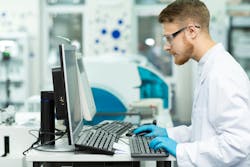The growing momentum of AI in digital pathology: An interview with Olga Colgan, PhD
1. How could workforce shortages and increasing diagnostic complexity accelerate the adoption of AI-driven digital pathology in clinical labs?
The pathology field, particularly diagnostic pathology, is experiencing a growing imbalance between demand and workforce capacity. On one hand, earlier screening programs and an aging global population are driving a significant increase in the number of samples requiring analysis. On the other hand, advances in personalized medicine, biomarker discovery, and immunotherapy are adding layers of complexity to each diagnosis. This means not only more samples, but also more tests per sample, and more sophisticated assays overall.
At the same time, the profession is grappling with a global shortage of pathologists. This workforce deficit is contributing to longer turnaround times, delayed diagnoses, and ultimately, delayed treatment for patients.
Artificial intelligence (AI)-driven digital pathology, while still in the early stages, is beginning to gain meaningful momentum as clinical labs look for scalable solutions to address these mounting challenges in diagnostic complexity and workforce capacity.
By digitizing slides, labs can:
- Enable remote work
- Improve flexibility for pathologists
- Make the field more attractive to new professionals.
AI tools can then be layered on top of this digital foundation to automate time-intensive tasks, such as slide quality control and slide prescreening, helping labs manage their workload more efficiently and accurately.
2. What are the key challenges pathology labs face in fully adopting digital pathology, and how does the integration of AI add both complexity and opportunity to this transition?
Technologically, high-throughput scanners, robust infrastructure, and mature image analysis software are now capable of supporting routine diagnostics. Regulatory bodies such as the Food and Drug Administration (FDA) and the European Commission, through frameworks like the Medical Device Regulation (MDR) and In Vitro Device Regulation (IVDR), have established clear pathways for digital pathology tools, and professional organizations have issued comprehensive guidelines.
However, cultural inertia persists. Pathology has traditionally been an analog discipline, and shifting to digital requires investment in training, infrastructure, and change management. The mindset of “if it’s not broken, why fix it?” can slow adoption. Overcoming this requires a shift in perception, viewing digital pathology not just as a replacement, but as a transformative enhancement, much like the cultural shift from sending physical mail to email. It’s about showing that while the transition requires effort, the long-term gains in efficiency and diagnostic quality are well worth it.
As more laboratories adopt digital pathology, this creates what I like to call a "flywheel effect." As more data becomes available, we create better AI tools. In turn, more laboratories are compelled to adopt digital pathology which enhances workflow efficiency.
Another consideration in adoption is the learning curve for pathologists transitioning to digital workflows. For someone used to viewing slides via a traditional microscope, navigating images on a screen takes some adjustment; digital slides can look slightly different to their physical counterparts. To ease this transition, laboratories are taking a gradual approach to adoption, starting with specific subsets of slides or tests.
Lastly, with AI-driven pathology, there is an opportunity for laboratories to optimize their tissue processing workflows to ensure they produce "digital-ready slides" that meet the needs of AI and digital systems. That’s where it becomes imperative for labs to collaborate with a partner who understands the full diagnostic continuum, from sample preparation to AI integration.
While the initial investment in digital transformation can be substantial, the long-term advantages are undeniable. In my experience, and what I often hear from customers, once a lab transitions to digital, it never goes back.
3. How is AI beginning to reshape the pathologist’s role in cancer detection and biomarker interpretation?
AI is poised to augment, not replace, the pathologist’s role. For tasks like cancer detection and biomarker interpretation, AI acts as a digital safety net: prescreening slides, highlighting suspicious areas, and providing consistent, quantifiable data. This is especially valuable in complex analyses involving multiple biomarkers or spatial relationships within the tumor microenvironment, where manual interpretation can be inconsistent.
By easing cognitive demands and supporting more data-informed decision making, AI is starting to redefine the role of pathologists. It’s similar to using a car’s navigation system: the pathologist remains in control, but benefits from intelligent guidance. As diagnostic complexity increases, AI will be essential for delivering reproducible, objective insights that support precision medicine.
4. How is computational pathology enabling faster, more accessible diagnostics that were once limited to specialty labs?
Computational pathology (or digitizing slides followed by automated analysis) is democratizing access to advanced diagnostics. By enabling objective, reproducible quantification of biomarkers, it allows general pathology labs to perform tests that once required external sendout.
This shift is especially impactful in regions with limited access to specialty labs. Digital slides can be shared remotely, and AI tools assist in interpreting complex patterns, raising diagnostic standards across diverse settings. For example, tests for certain cancers, which are often outsourced with long turnaround times, could be performed in-house on digitized images in minutes, saving time and cost.
As digital tools become more widely adopted across pathology labs, AI will support multiplex biomarker analysis, offering deeper insights into disease and enabling more personalized treatment plans. Initiatives like the UK’s National Pathology Imaging Co-operative (NPIC) are already demonstrating best practices by digitizing all slides, enabling remote access, and standardizing diagnostics across networks, ultimately improving patient care.
While proper sample preparation and quality control remain essential, computational pathology is helping to level the playing field, making expert-level diagnostics faster and more accessible than ever before.
5. How are advances in multiplexing, spatial profiling, and AI shaping the future of companion diagnostics for targeted therapies?
The future of companion diagnostics is being reshaped by the convergence of multiplexing, spatial profiling, and AI. Traditional immunohistochemistry (IHC) typically assesses one biomarker per slide. However, next-generation diagnostics require simultaneous analysis of multiple biomarkers to understand their spatial relationships within the tumor microenvironment.
Brightfield and fluorescence multiplexing now allow for the visualization of several markers on a single tissue section. Yet, interpreting these complex images manually is challenging. AI and automated image analysis are essential for extracting meaningful, quantitative insights from these data-rich images.
Spatial profiling adds another layer, revealing how biomarkers interact within specific cellular contexts. This spatial information is increasingly critical for predicting disease progression and therapeutic response. Together, these technologies are enabling more precise, personalized treatment strategies and driving the development of novel companion diagnostics.
About the Author

Olga Colgan, PhD.
has nearly two decades of experience in the digital pathology sector and is focused on how this new and disruptive technology can be leveraged to provide real benefits in both the healthcare and research domains. Before joining Leica Biosystems, she built her foundation in research, earning a BSc in Biotechnology and a PhD in Vascular Biology from Dublin City University, Ireland.
